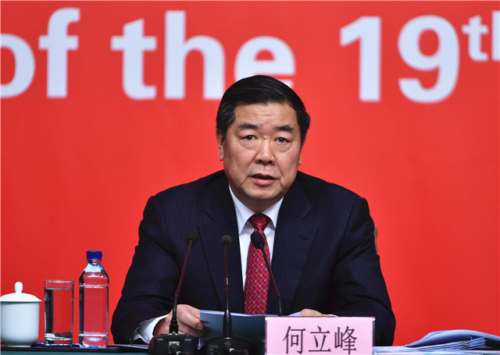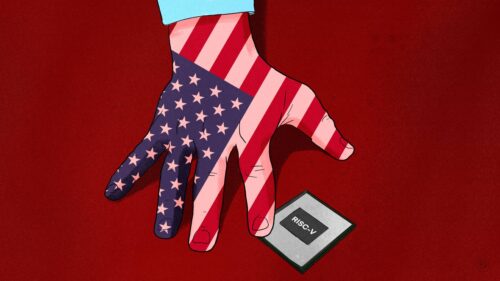Memory test: The U.S.-China chip war escalates
Concerns about security are deterring U.S. firms from cooperating with China on the production of memory chips. Paul Triolo argues the restrictions will also hurt U.S. and allied companies in addition to the intended target companies in China.

The semiconductor industry is on the front line of a cold war in technology. The United States has announced tight controls on exports to China of microprocessors, sometimes also called “logic chips.” These are the engines that drive advanced computing and supercomputers. In parallel, the U.S. has also tried to prevent the export of semiconductor manufacturing equipment to China.
Now another important category is under scrutiny: memory chips. These are ubiquitous in cell phones and tablets. In recent years, memory chips have vastly increased in capacity. The average cell phone now holds more memory in storage than was contained in an entire data center server, back in 2010.
A document explaining what types of semiconductors and computing equipment should be banned from export to China was published by the U.S. Department of Commerce in October. It was something of a surprise that it included advanced memory semiconductors.
Memory matters to the tech sector
Memory is an important income generator for the semiconductor industry and accounts for around 26% of its revenues.
Asia dominates the manufacture of memory chips, with around three quarters of global production. China is an increasingly important player. In 2019, around 15% of global memory capacity was located in China, with many semiconductor fabrication plants — commonly called “fabs” — operated by foreign multinationals.
So does the restriction on U.S. companies working with China on memory chips really stem from security concerns? Or is there primarily an economic motivation?
Companies in the U.S. are concerned about the generous subsidies that the Chinese government provides to its leading computer businesses, such as Yangtze Memory Technologies Corp, more commonly known as YMTC.
There is a widespread view that the input of state money causes market distortions that negatively impact American business.
An issue of national security
In a speech, U.S. National Security Adviser Jake Sullivan said that the U.S. government is implementing a policy of “small yard, high fence” when it comes to advanced technologies and China, including semiconductors. One of the goals outlined in a report by the U.S. National Security Committee is to “protect critical technologies.”
In addition, U.S. Secretary of Commerce Gina Raimondo has warned that China plans to use advanced semiconductors for military applications, such as components in weapons of mass destruction.
Although the National Security Committee’s report mentioned “logic” semiconductors, it was ambiguous about the security concerns associated with memory chips. Yet in the past few months, both Sullivan and Raimondo have spoken about both logic and memory in the same sentence, when referencing the need for export controls.
What has brought about this change?
Before we reach an answer, let us first challenge Jake Sullivan’s metaphor based on the concept of China as a small yard surrounded by a high fence. The semiconductor industry is not a small yard. It is in fact a vast, interconnected operation, which spans the globe.
Blowing up the bridges
A better metaphor would be to consider China as an island. The United States is trying to selectively destroy bridges and causeways that link this island’s semiconductor industry to the rest of the world. Despite this, some passages remain open, carrying trade with countries such as South Korea. The U.S. is also trying to extract a toll from this traffic. This is not easy, as these are busy roads, operating sophisticated supply chains.
The memory side of the semiconductor industry has become the topic of heated political debate in Washington. Some members of Congress wrote to Commerce Secretary Raimondo, demanding that the Chinese chip manufacturer YMTC be placed upon the so-called entity list — thus making it more or less impossible for U.S. companies to do business with it.
Apple has been drawn into the controversy. It was reported that Apple intended to try using NAND chips made by YMTC in iPhones and iPads. Sensationalist stories appeared online with headlines such as “China’s Army to Infiltrate iPhones with YMTC Chips.”
This prompted China’s critics in Congress to threaten to launch a probe of Apple over the issue. But there are questions about whether YMTC actually has the capability to supply Apple with chips containing the level of sophistication required with 128 layers. So far, YMTC remains off the entity list, and it says it will cooperate with the investigation.
The true motivation must be economic
All this suggests that the inclusion of memory chips on the export controls package is not about national security at all, but is actually primarily about economics, particularly when it comes to competition in the fast-growing parts of the industry, like NAND. However, the U.S. Department of Commerce may not have fully realized the implications of extending the technology war to the memory chip sector. In blowing up this bridge, it has risked causing considerable collateral damage.
The global memory market is international. Therefore, rules that place restrictions on American companies assisting fabs in China from making NAND chips with 128 layers or DRAM chips at 18 nm would have a major impact on the foreign multinational companies that own the factories.
When this important point was realized, there was a scramble to assemble a pontoon bridge: a one-year license for companies that operate in China.
Without that hastily-agreed-to reprieve, some facilities, like those belonging to South Korean giants Samsung and SK Hynix, could have ceased to function normally, throwing the global memory market into chaos. Because foreign multinationals operating in China hold a much larger global market share than the domestic firms, the new export control rules had the potential to cause more problems for foreign firms than for China.
The U.S. upsets its allies
South Korean firms are particularly concerned about their future operations in China, where they have invested billions of dollars. As Rhodium Group put it: “Foreign chip-makers SK Hynix and Samsung, now at the mercy of U.S. licensing decisions, are likely to face significant costs linked to the restructuring of their supply chains.”
SK Hynix called the controls painful and has speculated that it may need to eventually shed its China-based operations. Samsung has said it hopes the special extension will be allowed to continue. All this uncertainty is problematic, given the need to plan long-term capital expenditures. A cloud has gathered over China-based operations of the major memory players, with complex future technology upgrade paths unclear.
For equipment makers, the memory segment is extremely important, particularly as demand for NAND chips in smartphones and data centers increases now that many countries are recovering from COVID economic downturns. SK Hynix produces 40% of its DRAM supplies in China, constituting around 15% of global output, and Samsung produces 40% of its in-house NANDs in China.
The long-term impact on both the memory sector and downstream companies is significant. Memory is a price-sensitive industry, so companies tend to operate on narrow margins. If firms are forced to relocate out of China, this would have a detrimental impact on other industries, such as those involved in consumer electronics or information and communications technology (ICT).
The industry is asking if U.S. policy toward China will lead to major disruption, or even a global chip shortage. There has not been much reassurance from Alan Estevez, the under secretary of commerce for industry and security at the U.S. Department of Commerce, who is responsible for overseeing export controls. He has stated: “We do not balance trade with national security. When I see an action that needs to be taken for national security, I have top-down coverage to take care of that — regardless of the impact.”






